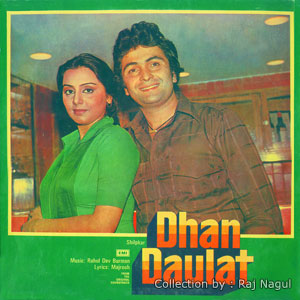Wo jinki nayee hai duniya

Film: Dhan Daulat (1980)
Producer: Vinod Shah
Director: Harish Shah
Lyricist: Majrooh Sultanpuri
Singers: Asha Bhosle, Kishore Kumar and chorus
It’s always a pleasure to find lesser-known creations of Pancham. Every new “discovery” (or rediscovery) is akin to a roller coaster ride filled with emotions of surprise, bewilderment and fun, almost always leading to ecstasy. The discovery first gets cherished and savored in solitude. Then it gets enthusiastically shared among like-minded Panchamaniacs. And then it rules the collective conscience of the loRD’s many admirers for weeks on end.
I distinctly remember one such fun ride I had when I found this song from the film Dhan Daulat (1980).
A catchy number, the song has all the dizzying elements of any pleasantly exciting experience.
The fun starts right away as the song opens to a fresh sound − probably a xylophone and/or synthesizer – set to a racy beat. As the intro music starts to caress one’s auditory senses, Asha Bhosle announces her regal arrival with an intoxicating “Pa pa Pa, Pa pa, Pa pa Pa – Pa, Pa, Pa….” The stage is now set. You can intuitively sense that something extra-special is about to follow. And what follows is a kaleidoscope of musical improvisations, dazzling and soothing – both at the same time.
Penned by Majrooh Sultanpuri, this song is a celebration of new beginnings; urging you to look forward to a new world, new destinations. The way Asha sings “Peechhe nahee dekha karte…” makes you want to forget the past and crave for what lies ahead.
The song is picturized on Rishi Kapoor and a pretty Daljit Kaur who (Wikipedia informs us) is known as the Hema Malini of Punjabi films! It’s set in a party, where Prem Chopra has tasked Ms Kaur with enticing Rishi Kapoor toward a nai duniya, nai manzil.
The mukhda progresses at a steady pace to the accompaniment of beautiful background violins, occasional plucking of an electric guitar, back-up rhythms on a base guitar and gentle taps of a stick on the rim of a drum-set. It’s grand, yet subtle. Peppy, yet melodious!
The transition from the mukhda to the antara is a short but energetic piece of electric guitar that magically ends up changing the scale. First of many scale changes to follow!
The antara starts a scale higher and gradually descends back to the original scale of the song. This playfulness continues all through the song like a melodious roller coaster, with all its twists and turns.
Just when you think the song has settled into a predictable pattern, the grandest of surprises unravels during the second interlude. Another energetic piece! This time on violins! The violins take some sharp twists and turns before reaching a crescendo. This is the cue for Kishore Kumar’s arrival. He enters with a zesty “La La La La LaLa LalaLa,” delivered in all the masculine glory reserved for a Bollywood hero, executed in a manner that only Kishoreda can. The song scales a new peak from here on, going through several more scale changes and improvisations, but never losing its melodious soul. It manages to achieve and sustain an ecstatic feeling that leaves you craving for more as it fades off into a chorus.
Majrooh Sultanpuri probably knew that Pancham would compose a memorable tune to decorate his lyrics. This is probably why the last antara appropriately ends with the words − “Ek hum kya hain is dhun ke deewane sabhee”!
The dhun did make me a deewana when I first discovered this song. The deewangee just refuses to wear off…fortunately!
Gopal Iyer
panchammagic.org

